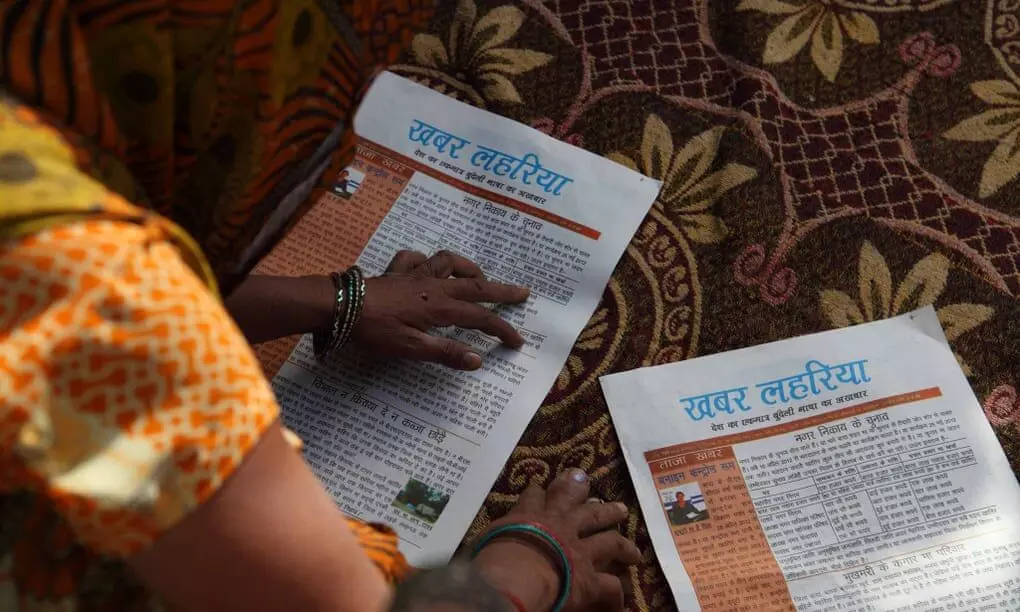Blazing a trail
Writing with Fire shows how journalism has empowered a group of Dalit women reporters, but also how having a voice has made them susceptible to uncertainties, writes Joyshree Baruah.

An unpretentious scene from Writing with Fire shows a few women ecstatically unboxing smartphones, with apprehensions over not being able to use them correctly. Directed by Rintu Thomas and Sushmit Ghosh, the documentary follows the staffers of Khabar Lahariya, chronicling their journey, including their switch to the digital format, with print proving unsustainable. It has become the first Indian feature documentary to be nominated for an Academy Award for Best Documentary Feature.
The subject of the documentary is the journey of Khabar Lahariya, India's only newspaper run exclusively by Dalit women journalists. "We are proud that 20 years of our rural reporting and hard work is being appreciated and loved by a global audience; encouraging us to further our women-led grassroots media revolution," says Kavita Devi, co-founder of Khabar Lahariya. The documentary follows Meera and her fellow journalists, when they get acquainted with new technology whilst questioning patriarchy and covering a gamut of daring stories like caste and gender violence, unacknowledged deaths in illegal mines, lack of water, electricity, sanitation, healthcare, incompetence of the local administration, etc.
Since its inception in Chitrakoot, UP, in 2002, Khabar Lahariya, which literally translates to news waves, has indeed been making waves. It was New Delhi-based NGO Nirantar which began the country's first-of-its's-kind, rural newspaper from Bundelkhand district – a semi-arid region where 60 per cent of the population depends on agriculture for sustenance. Their aim was to bring rural women into the sphere of journalism, information and technology. Initially, the paper was printed fortnightly, and hand-delivered by the reporters who were out in the villages gathering stories. As smartphones and internet usage increased in India, Khabar Lahariya has adopted a digital-first strategy. Its reporters are filing video reports, and instant updates on WhatsApp and Facebook, to reach new audiences. Today, it reaches over five million people a month through multiple digital platforms. Interestingly, the now-weekly print paper also has a loyal readership. The team of 30-plus reporters and stringers, comprising members of the Kol tribe and Muslim communities, has been fighting for gender parity and grassroots democracy. "We have been called a powerful local watchdog, an instrument for enforcing robust grassroots governance and accountability", reads their website's 'About Us' section.
Over the past decade, a digital revolution has swept across India, and more than 350 million Indians have access to the internet, most of them on smartphones. "People in rural India are looking for news that's local, and there's no one else apart from Khabar Lahariya that's really giving that to them," says Suhas Mishra, a businessman who has invested in the paper.
The unfortunate reality in the country is that women's presence as journalists is notoriously stifled. For the women of Khabar Lahariya, the rise has been an uphill task. Still continuing to go against the myriad odds stacked against them, they have faced threats and danger while working, which is relatable to many other women journalists of the country. "We are often intimidated and ridiculed for doing our jobs," says Sanghamitra Datta, a senior journalist with a leading national daily. "Women journalists are subjected to several forms of discrimination, harassment and violence, with minorities at an increased risk for violence and emotional trauma. Sexism at the workplace is a different story altogether," she adds. According to the report 'Sexism in Journalism' by Reporters Without Borders, a non-governmental organisation committed to journalistic freedom, women journalists face significant risks of sexism and sexual violence, with 40 countries identified as "dangerous" or "very dangerous" for women journalists. The report defines "sexism" as "all forms of gender-based violence, including discrimination, insults, sexual harassment, unwanted touching, verbal and physical sexual assaults, threats of rape and even rape itself". Implementing greater vigilance, betting on education to end sexual stereotypes and raising awareness by putting in place internal emergency and alert devices are the need of the hour to ensure equality.
"At a time when the profession faces increasing dangers in India, Khabar Lahariya continues to tread centuries of patriarchy and caste prejudice with measure and grace," says Nayanthara Darai, an independent filmmaker from Odisha. "The makers have captured scenes with earthy honesty and a vivid sense of these strong women who refuse to give up, inspiring many other women." Blazing a trail with its subject as well as narration, Writing with Fire is up against Ascension, Attica, Flee, and Summer of Soul (...Or, When the Revolution Could Not Be Televised) for the Oscar, which will be announced on March 28.
